Mechanisms underlying the protective effect of tannic acid against arsenic trioxide‑induced cardiotoxicity in rats: Potential involvement of mitochondrial apoptosis
- Authors:
- Yucong Xue
- Mengying Li
- Yurun Xue
- Weiyue Jin
- Xue Han
- Jianping Zhang
- Xi Chu
- Ziliang Li
- Li Chu
-
Affiliations: School of Pharmacy, Hebei University of Chinese Medicine, Shijiazhuang, Hebei 050200, P.R. China, School of Basic Medicine, Hebei University of Chinese Medicine, Shijiazhuang, Hebei 050200, P.R. China, The Fourth Hospital of Hebei Medical University, Shijiazhuang, Hebei 050011, P.R. China - Published online on: October 11, 2020 https://doi.org/10.3892/mmr.2020.11586
- Pages: 4663-4674
-
Copyright: © Xue et al. This is an open access article distributed under the terms of Creative Commons Attribution License.
This article is mentioned in:
Abstract
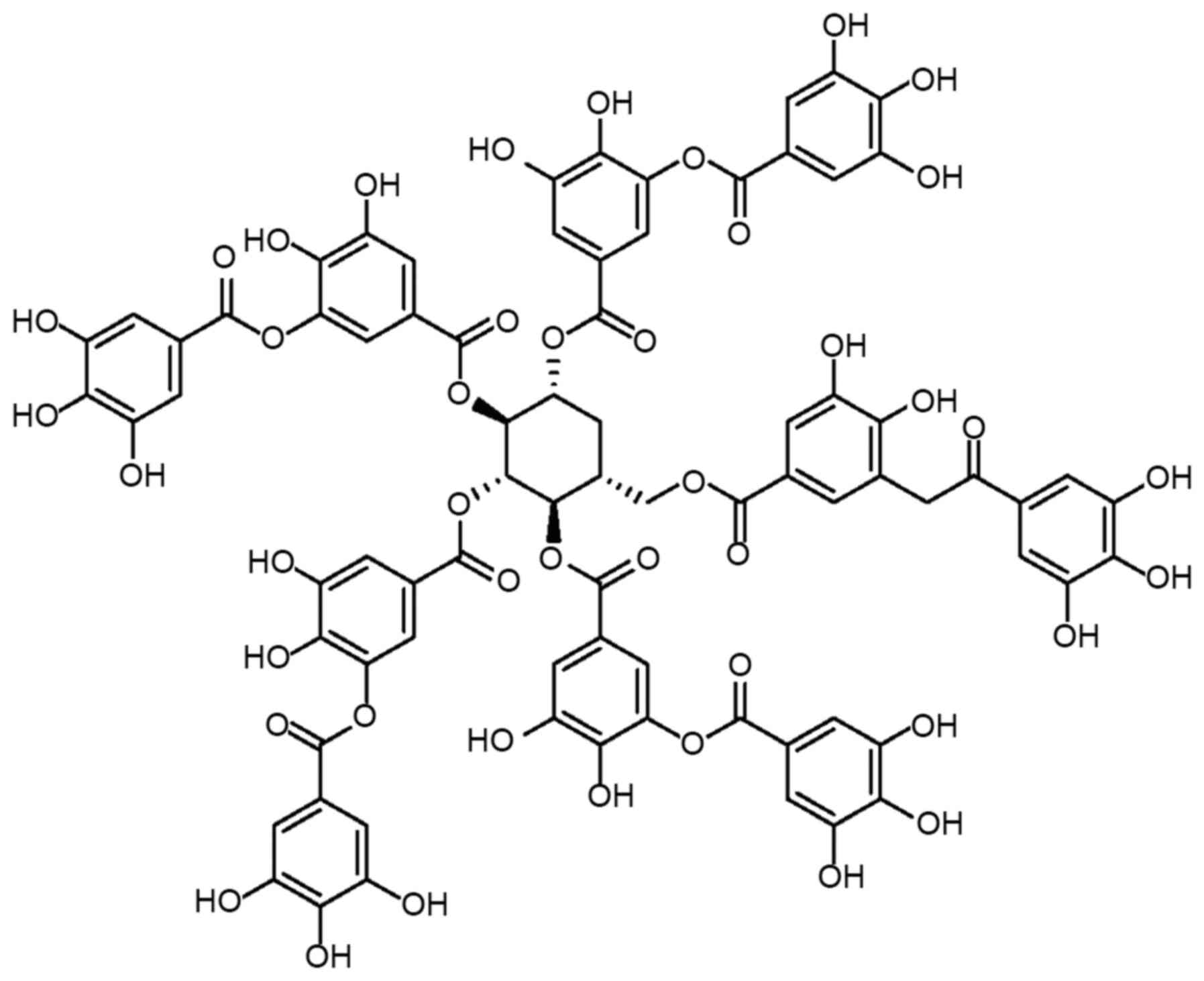 |
 |
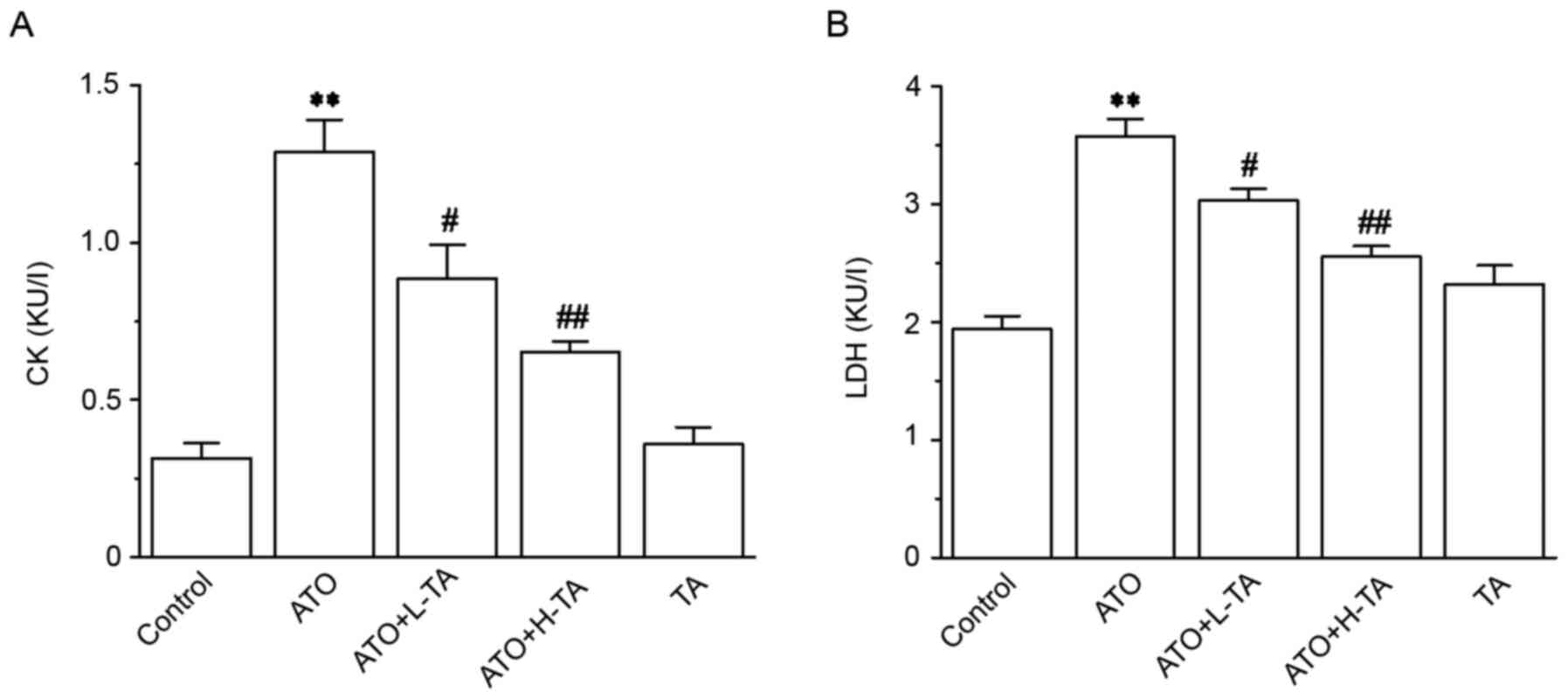 |
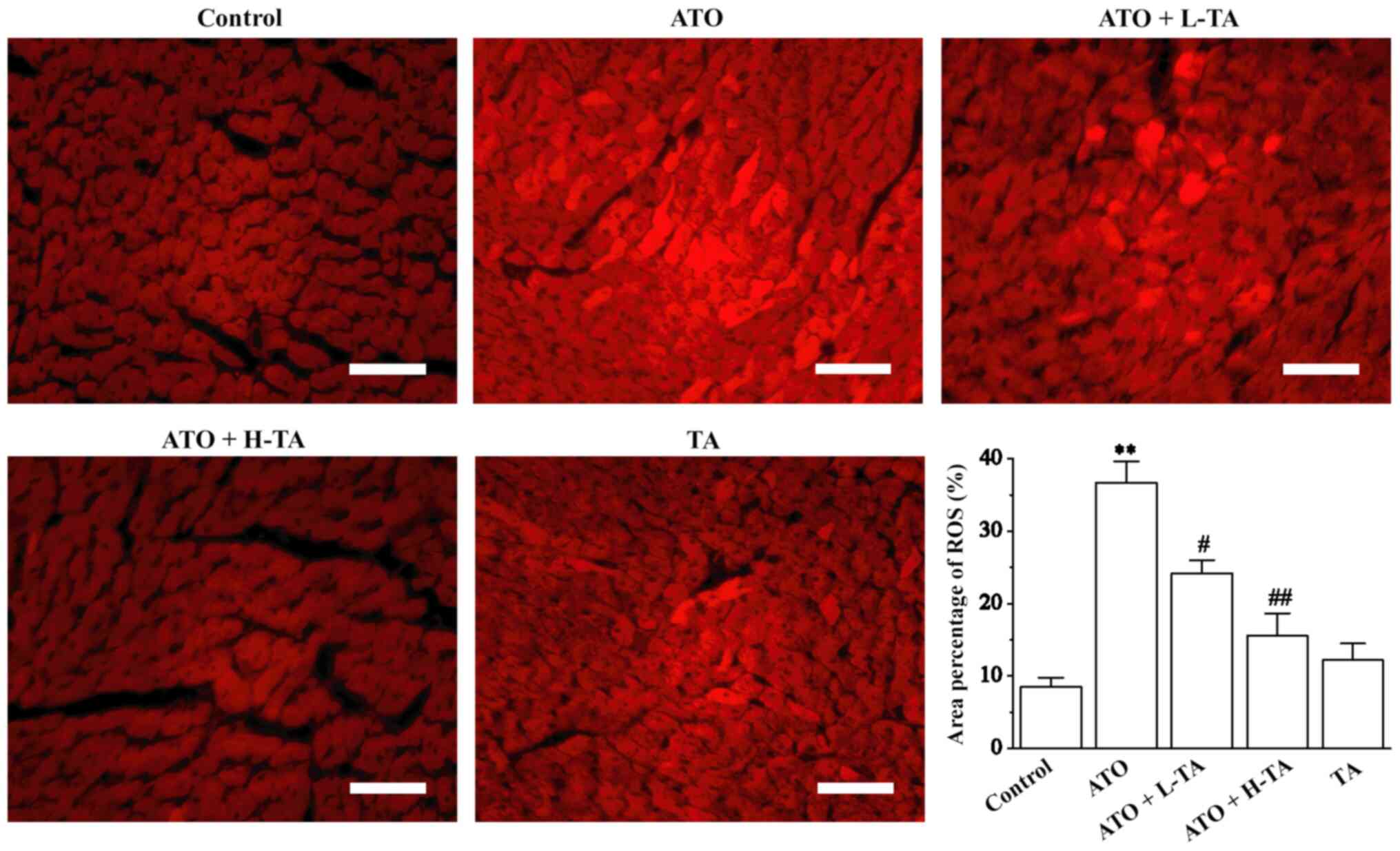 |
 |
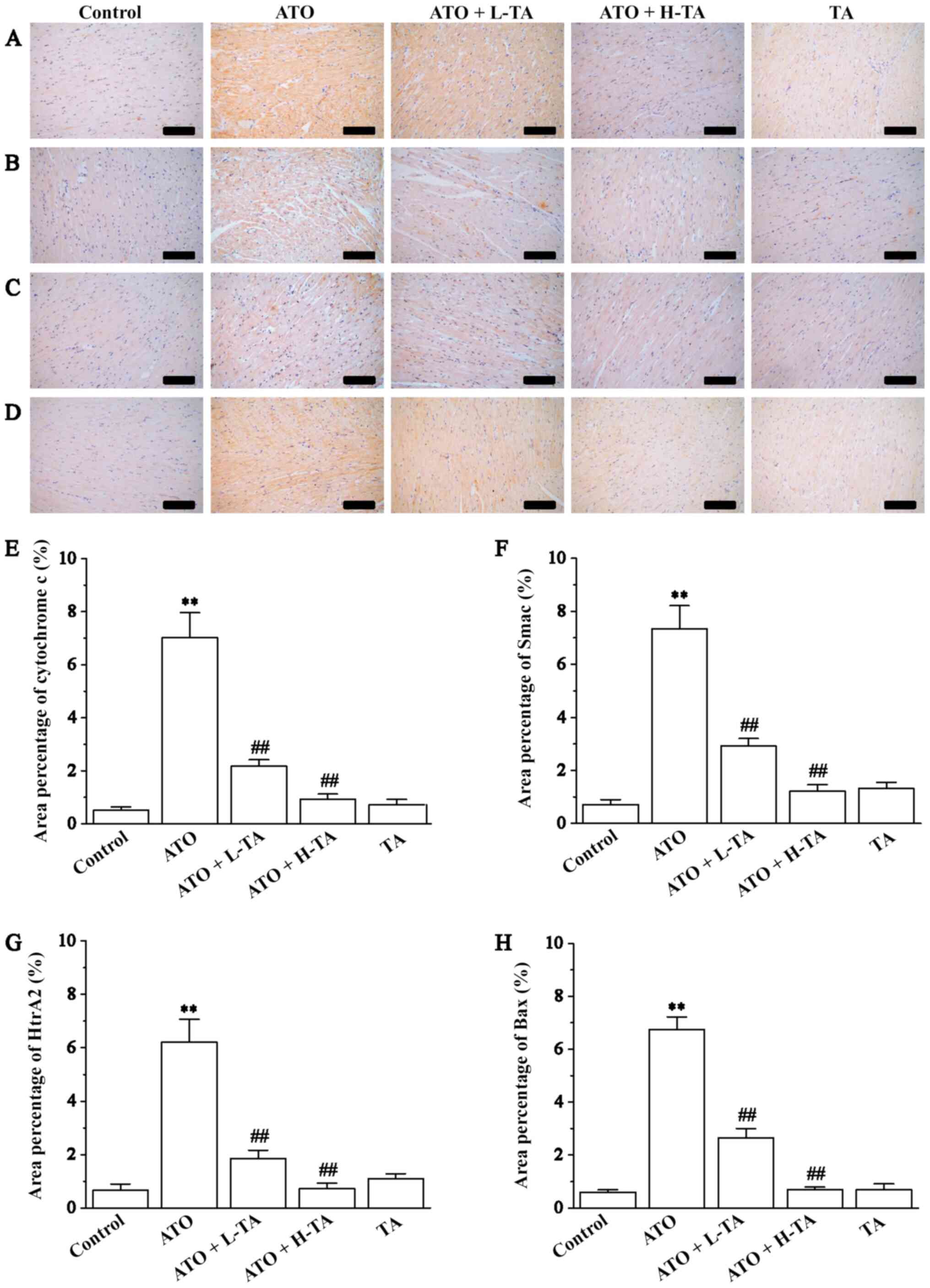 |
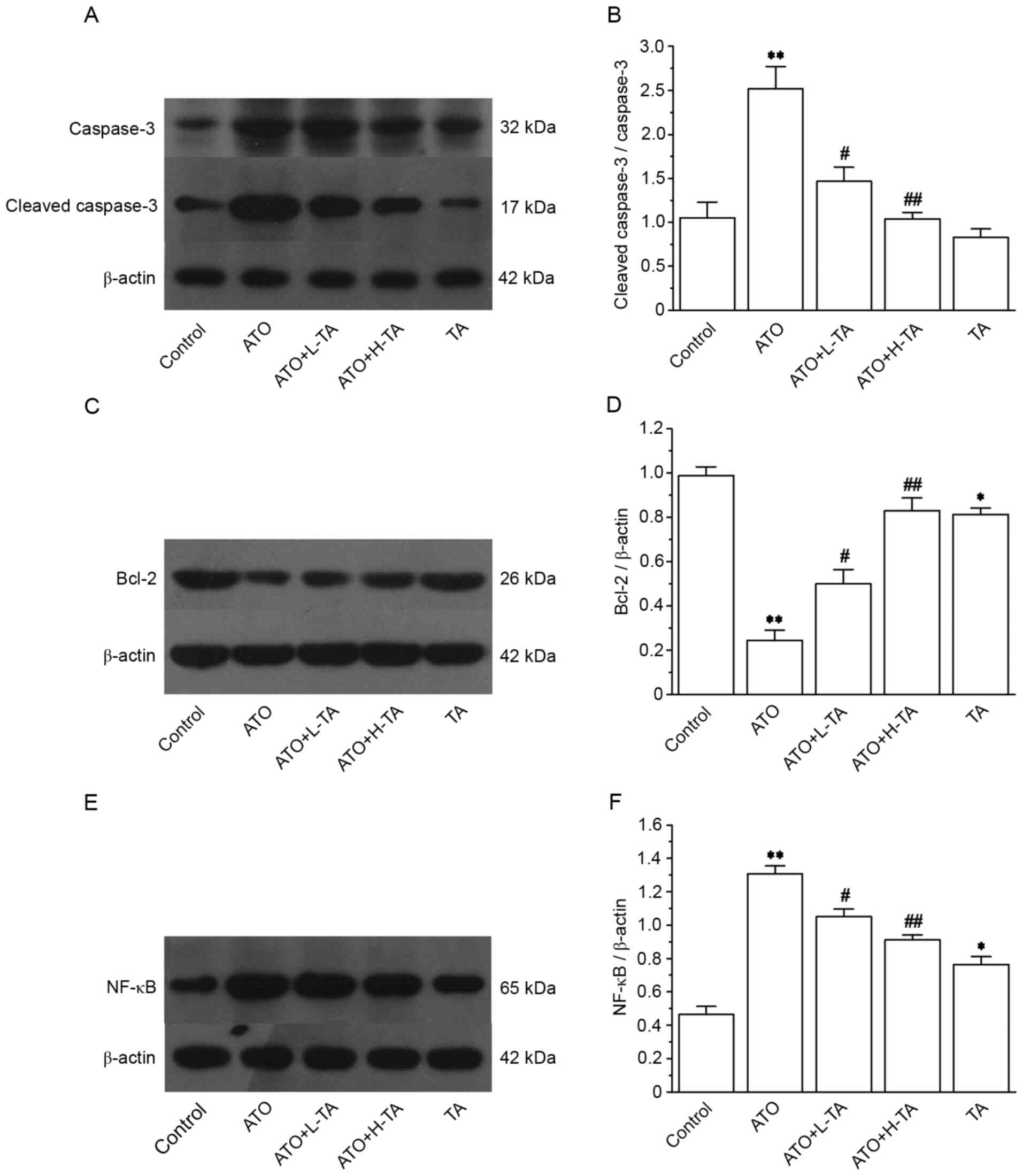 |
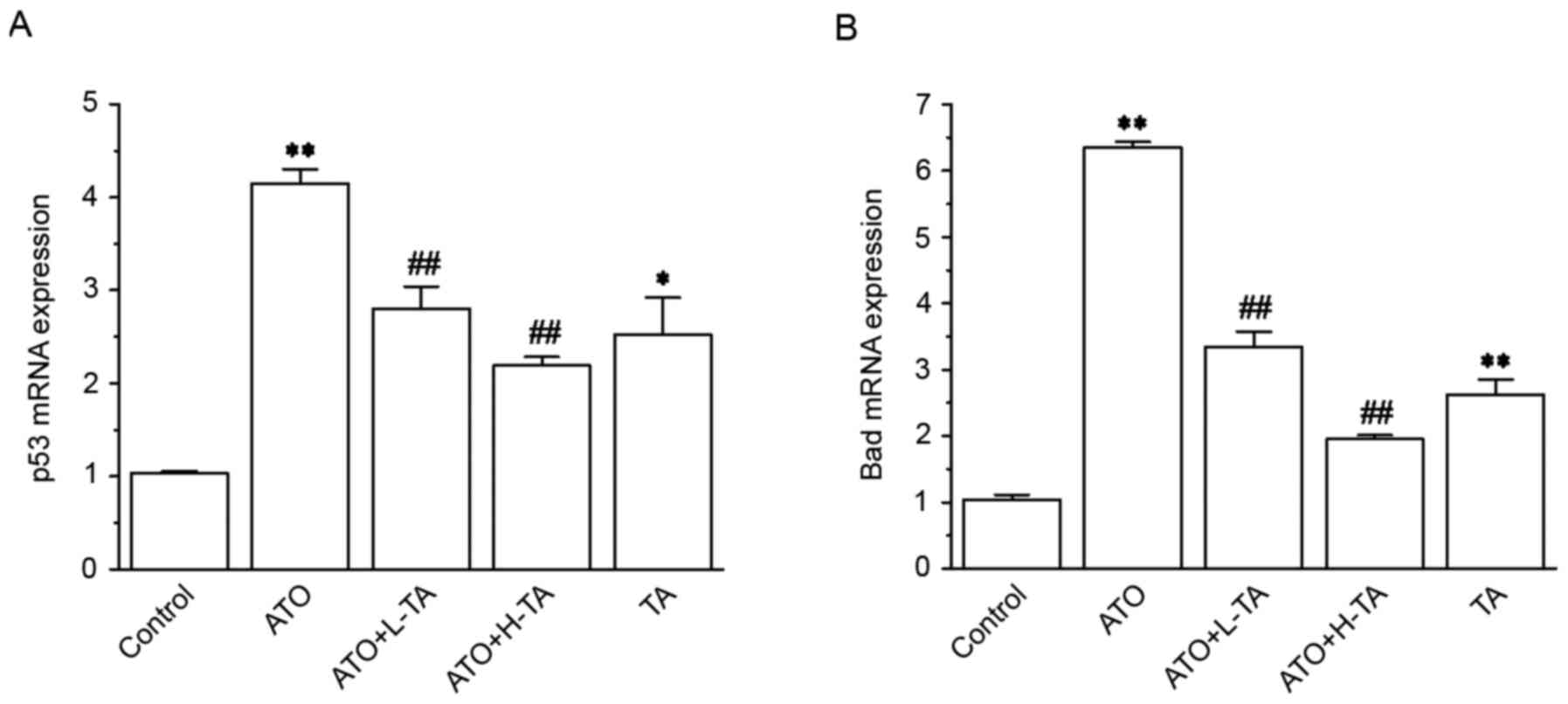 |
|
Alamolhodaei NS, Shirani K and Karimi G: Arsenic cardiotoxicity: An overview. Environ Toxicol Pharmacol. 40:1005–1014. 2015. View Article : Google Scholar : PubMed/NCBI | |
|
Manna P, Sinha M and Sil PC: Arsenic-induced oxidative myocardial injury: Protective role of arjunolic acid. Arch Toxicol. 82:137–149. 2008. View Article : Google Scholar : PubMed/NCBI | |
|
Mathews V, Chendamarai E, George B, Viswabandya A and Srivastava A: Treatment of acute promyelocytic leukemia with single-agent arsenic trioxide. Mediterr J Hematol Infect. 3:e20110562011. View Article : Google Scholar | |
|
Zhang TC, Cao EH, Li JF, Ma W and Qin JF: Induction of apoptosis and inhibition of human gastric cancer MGC-803 cell growth by arsenic trioxide. Eur J Cancer. 35:1258–1263. 1999. View Article : Google Scholar : PubMed/NCBI | |
|
Shen ZY, Zhang Y, Chen JY, Chen MH, Shen J, Luo WH and Zeng Y: Intratumoral injection of arsenic to enhance antitumor efficacy in human esophageal carcinoma cell xenografts. Oncol Rep. 11:155–159. 2004.PubMed/NCBI | |
|
Akao Y, Nakagawa Y and Akiyama K: Arsenic trioxide induces apoptosis in neuroblastoma cell lines through the activation of caspase 3 in vitro. FEBS Lett. 455:59–62. 1999. View Article : Google Scholar : PubMed/NCBI | |
|
Tai S, Xu LF, Xu M, Zhang LG, Zhang YY, Zhang KP, Zhang L and Liang CZ: Combination of arsenic trioxide and everolimus (Rad001) synergistically induces both autophagy and apoptosis in prostate cancer cells. Oncotarget. 8:11206–11218. 2017. View Article : Google Scholar : PubMed/NCBI | |
|
Bao ZY, Han ZB, Zhang B, Yu Y, Xu ZH, Ma WY, Ding FZ, Zhang L, Yu MX, Liu SZ, et al: Arsenic trioxide blocked proliferation and cardiomyocyte differentiation of human induced pluripotent stem cells: Implication in cardiac developmental toxicity. Toxicol Lett. 309:51–58. 2019. View Article : Google Scholar : PubMed/NCBI | |
|
Liu YS, Liang YR, Zheng B, Chu L, Ma DL, Wang HF, Chu X and Zhang JP: Protective Effects of crocetin on arsenic trioxide-induced hepatic injury: Involvement of suppression in oxidative stress and inflammation through activation of Nrf2 signaling pathway in rats. Drug Des Devel Ther. 14:1921–1931. 2020. View Article : Google Scholar : PubMed/NCBI | |
|
Unnikrishnan D, Dutcher JP, Garl S, Varshneya N, Lucariello R and Wiernik PH: Cardiac monitoring of patients receiving arsenic trioxide therapy. Br J Haematol. 124:610–617. 2004. View Article : Google Scholar : PubMed/NCBI | |
|
Mu MY, Zhao HJ, Wang Y, Liu JJ, Fei DX and Xing MW: Arsenic trioxide or/and copper sulfate co-exposure induce glandular stomach of chicken injury via destruction of the mitochondrial dynamics and activation of apoptosis as well as autophagy. Ecotoxicol Environ Saf. 185:1096782019. View Article : Google Scholar : PubMed/NCBI | |
|
Badarkhe GV, Sil A, Bhattacharya S, Nath UK and Das NK: Erythema multiforme due to arsenic trioxide in a case of acute promyelocytic leukemia: A diagnostic challenge. Indian J Pharmacol. 48:216–218. 2016. View Article : Google Scholar : PubMed/NCBI | |
|
Roboz GJ, Ritchie EK, Carlin RF, Samuel M, Gale L, Provenzano-Gober JL, Curcio TJ, Feldman EJ and Kligfield PD: Prevalence, management, and clinical consequences of QT interval prolongation during treatment with arsenic trioxide. J Clin Oncol. 32:3723–3728. 2014. View Article : Google Scholar : PubMed/NCBI | |
|
Hai JJ, Gill H, Tse HF, Kumana CR, Kwong YL and Siu CW: Torsade de pointes during oral arsenic trioxide therapy for acute promyelocytic leukemia in a patient with heart failure. Ann Hematol. 94:501–503. 2015. View Article : Google Scholar : PubMed/NCBI | |
|
Zhang Y, Wei ZK, Liu WJ, Wang JJ, He XX, Huang HL, Zhang JL and Yang ZT: Melatonin protects against arsenic trioxide-induced liver injury by the upregulation of Nrf2 expression through the activation of PI3K/AKT pathway. Oncotarget. 8:3773–3780. 2017. View Article : Google Scholar : PubMed/NCBI | |
|
Wang XN, Zhao HY, Shao YL, Wang P, Wei YR, Zhang WQ, Jiang J, Chen Y and Zhang Z: Nephroprotective effect of astaxanthin against trivalent inorganic arsenic-induced renal injury in wistar rats. Nutr Res Pract. 8:46–53. 2014. View Article : Google Scholar : PubMed/NCBI | |
|
Cheng Y, Xue J, Jiang H, Wang M, Gao L, Ma D and Zhang Z: Neuroprotective effect of resveratrol on arsenic trioxide-induced oxidative stress in feline brain. Hum Exp Toxicol. 33:737–747. 2014. View Article : Google Scholar : PubMed/NCBI | |
|
Ahamed M, Akhtar MJ and Alhadlaq HA: Co-exposure to SiO2 nanoparticles and arsenic induced augmentation of oxidative stress and mitochondria-dependent apoptosis in human cells. Int J Environ Res Public Health. 16:31992019. View Article : Google Scholar | |
|
Sabbah HN: Targeting the mitochondria in heart failure: A translational perspective. JACC Basic Transl Sci. 5:88–106. 2020. View Article : Google Scholar : PubMed/NCBI | |
|
Chistiakov DA, Shkurat TP, Melnichenko AA, Grechko AV and Orekhov AN: The role of mitochondrial dysfunction in cardiovascular disease: A brief review. Ann Med. 50:121–127. 2018. View Article : Google Scholar : PubMed/NCBI | |
|
Roy D, Felty Q, Narayan S and Jayakar P: Signature of mitochondria of steroidal hormones-dependent normal and cancer cells: Potential molecular targets for cancer therapy. Front Biosci. 12:154–173. 2007. View Article : Google Scholar : PubMed/NCBI | |
|
Brown DA, Perry JB, Allen ME, Sabbah HN, Stauffer BL, Shaikh SR, Cleland JG, Colucci WS, Butler J, Voors AA, et al: Expert consensus document: Mitochondrial function as a therapeutic target in heart failure. Nat Rev Cardiol. 14:238–250. 2017. View Article : Google Scholar : PubMed/NCBI | |
|
Pohjoismäki JL and Goffart S: The role of mitochondria in cardiac development and protection. Free Radic Biol Med. 106:345–354. 2017. View Article : Google Scholar : PubMed/NCBI | |
|
Peoples JN, Saraf A, Ghazal N, Pham TT and Kwong JQ: Mitochondrial dysfunction and oxidative stress in heart disease. Exp Mol Med. 51:1–13. 2019. View Article : Google Scholar : PubMed/NCBI | |
|
Abdelrahman RS, El-Awady MS, Nader MA and Ammar EM: Hydrogen sulfide ameliorates cardiovascular dysfunction induced by cecal ligation and puncture in rats. Hum Exp Toxicol. 34:953–964. 2015. View Article : Google Scholar : PubMed/NCBI | |
|
Gill C, Mestril R and Samali A: Losing heart: The role of apoptosis in heart disease-a novel therapeutic target? FASEB J. 16:135–146. 2002. View Article : Google Scholar : PubMed/NCBI | |
|
Yu XJ, Wang ZY, Shu ZP, Li ZQ, Ning Y, Yun KL, Bai HN, Liu RH and Liu WL: Effect and mechanism of Sorbus pohuashanensis (Hante) Hedl. Flavonoids protect against arsenic trioxide-induced cardiotoxicity. Biomed Pharmacother. 88:1–10. 2017. View Article : Google Scholar : PubMed/NCBI | |
|
McDonough KH: The role of alcohol in the oxidant antioxidant balance in heart. Front Biosci. 4:D601–D606. 1999. View Article : Google Scholar : PubMed/NCBI | |
|
Wang Y, Wu YP, Wang YY, Xu H, Mei XQ, Yu DY, Wang YB and Li WF: Antioxidant properties of probiotic bacteria. Nutrients. 9:5212017. View Article : Google Scholar | |
|
Vineetha VP, Soumya RS and Raghu KG: Phloretin ameliorates arsenic trioxide induced mitochondrial dysfunction in H9c2 cardiomyoblasts mediated via alterations in membrane permeability and ETC complexes. Eur J Pharmacol. 754:162–172. 2015. View Article : Google Scholar : PubMed/NCBI | |
|
Lindskog M, Gleissman H, Ponthan F, Castro J, Kogner P and Johnsen JI: Neuroblastoma cell death in response to docosahexaenoic acid: Sensitization to chemotherapy and arsenic-induced oxidative stress. Int J Cancer. 118:2584–2593. 2006. View Article : Google Scholar : PubMed/NCBI | |
|
Chen H, Liu G, Qiao N, Kang Z, Hu L, Liao J, Yang F, Pang C, Liu B, Zeng Q, et al: Toxic effects of arsenic trioxide on spermatogonia are associated with oxidative stress, mitochondrial dysfunction, autophagy and metabolomic alterations. Ecotoxicol Environ Saf. 190:1100632020. View Article : Google Scholar : PubMed/NCBI | |
|
Patlolla AK and Tchounwou PB: Serum acetyl cholinesterase as a biomarker of arsenic induced neurotoxicity in sprague-dawley rats. Int J Environ Res Public Health. 2:80–83. 2005. View Article : Google Scholar : PubMed/NCBI | |
|
Vineetha VP and Raghu KG: An overview on arsenic trioxide-induced cardiotoxicity. Cardiovasc Toxicol. 19:105–119. 2019. View Article : Google Scholar : PubMed/NCBI | |
|
Amini-Khoei H, Hosseini MJ, Momeny M, Rahimi-Balaei M, Amiri S, Haj-Mirzaian A, Khedri M, Jahanabadi S, Mohammadi-Asl A, Mehr SE and Dehpour AR: Morphine attenuated the cytotoxicity induced by arsenic trioxide in H9c2 cardiomyocytes. Biol Trace Elem Res. 173:132–139. 2016. View Article : Google Scholar : PubMed/NCBI | |
|
Ghosh J, Das J, Manna P and Sil PC: Taurine prevents arsenic-induced cardiac oxidative stress and apoptotic damage: Role of NF-kappa B, p38 and JNK MAPK pathway. Toxicol Appl Pharmacol. 240:73–87. 2009. View Article : Google Scholar : PubMed/NCBI | |
|
Zhang JY, Sun GB, Luo Y, Wang M, Wang W, Du YY, Yu YL and Sun XB: Salvianolic acid a protects H9c2 cells from arsenic trioxide-induced injury via inhibition of the MAPK signaling pathway. Cell Physiol Biochem. 41:1957–1969. 2017. View Article : Google Scholar : PubMed/NCBI | |
|
Zhu S, Wang Y, Liu H, Wei W, Tu Y, Chen C, Song J, Xu Z, Li J, Wang C and Sun S: Thyroxine affects lipopolysaccharide-induced macrophage differentiation and myocardial cell apoptosis via the NF-κB p65 pathway both in vitro and in vivo. Mediators Inflamm. 2019:20989722019. View Article : Google Scholar : PubMed/NCBI | |
|
Liu X, Kim J, Li Y, Li J, Liu F and Chen X: Tannic acid stimulates glucose transport and inhibits adipocyte differentiation in 3T3-L1 cells. J Nutr. 135:165–171. 2005. View Article : Google Scholar : PubMed/NCBI | |
|
Hemmati AA, Olapour S, Varzi HN, Khodayar MJ, Dianat M, Mohammadian B and Yaghooti H: Ellagic acid protects against arsenic trioxide-induced cardiotoxicity in rat. Hum Exp Toxicol. 37:412–419. 2018. View Article : Google Scholar : PubMed/NCBI | |
|
Ashafaq M, Sharma P, Khatoon S, Haque D, Tabassum H and Parvez S: Heavy metal-induced systemic dysfunction attenuated by tannic acid. J Environ Pathol Toxicol Oncol. 35:109–120. 2016. View Article : Google Scholar : PubMed/NCBI | |
|
Zhang JP, Cui LJ, Han X, Zhang YY, Zhang X, Chu X, Zhang FH, Zhang Y and Chu L: Protective effects of tannic acid on acute doxorubicin-induced cardiotoxicity: Involvement of suppression in oxidative stress, inflammation, and apoptosis. Biomed Pharmacother. 93:1253–1260. 2017. View Article : Google Scholar : PubMed/NCBI | |
|
Chu L, Li PY, Song T, Han X, Zhang X, Song QT, Liu T, Zhang YY and Zhang JP: Protective effects of tannic acid on pressure overload-induced cardiac hypertrophy and underlying mechanisms in rats. J Pharm Pharmacol. 69:1191–1207. 2017. View Article : Google Scholar : PubMed/NCBI | |
|
Zhu FL, Chu X, Wang H, Zhang X, Zhang YY, Liu ZY, Guo H, Liu HY, Liu Y, Chu L and Zhang JP: New Findings on the effects of tannic acid: Inhibition of L-Type calcium channels, Calcium transient and contractility in rat ventricular myocytes. Phytother Res. 30:510–516. 2016. View Article : Google Scholar : PubMed/NCBI | |
|
Jin WY, Xue YR, Xue YC, Han X, Song QT, Zhang JP, Li ZL, Cheng J, Guan SJ, Sun SJ and Chu L: Tannic acid ameliorates arsenic trioxide-induced nephrotoxicity, contribution of NF-κB and Nrf2 pathways. Biomed Pharmacother. 126:1100472020. View Article : Google Scholar : PubMed/NCBI | |
|
Kumazaki M, Ando H, Sasaki A, Koshimizu TA, Ushijima K, Hosohata K, Oshima Y and Fujimura A: Protective effect of α-lipoic acid against arsenic trioxide-induced acute cardiac toxicity in rats. J Pharmacol Sci. 115:244–248. 2011. View Article : Google Scholar | |
|
Miao X, Tang ZF, Wang YG, Su GF, Sun WX, Wei W, Li W, Miao LN, Cai L, Tan Y and Liu QJ: Metallothionein prevention of arsenic trioxide-induced cardiac cell death is associated with its inhibition of mitogen-activated protein kinases activation in vitro and in vivo. Toxicol Lett. 220:277–285. 2013. View Article : Google Scholar : PubMed/NCBI | |
|
Saxena PN, Anand S, Saxena N and Bajaj P: Effect of arsenic trioxide on renal functions and its modulation by curcuma aromatica leaf extract in albino rat. J Environ Biol. 30:527–531. 2009.PubMed/NCBI | |
|
Liu J, Lu Y, Wu Q, Goyer RA and Waalkes MP: Mineral arsenicals in traditional medicines: Orpiment, realgar, and arsenolite. J Pharmacol Exp Ther. 326:363–368. 2008. View Article : Google Scholar : PubMed/NCBI | |
|
Song J, Ding WB, Liu BJ, Liu D, Xia Z, Zhang L, Cui L, Luo Y, Jia XB and Feng L: Anticancer effect of caudatin in diethylnitrosamine-induced hepatocarcinogenesis in rats. Mol Med Rep. 22:697–706. 2020. View Article : Google Scholar : PubMed/NCBI | |
|
Livak KJ and Schmittgen TD: Analysis of relative gene expression data using real-time quantitative PCR and the 2(-Delta Delta C(T)) method. Methods. 25:402–408. 2001. View Article : Google Scholar : PubMed/NCBI | |
|
Costa VM, Carvalho F, Duarte JA, Bastos Mde L and Remiao F: The heart as a target for xenobiotic toxicity: The cardiac susceptibility to oxidative stress. Chem Res Toxicol. 26:1285–1311. 2013. View Article : Google Scholar : PubMed/NCBI | |
|
James TN: Long reflections on the QT interval: The sixth annual Gordon K. Moe Lecture. J Cardiovasc Electrophysiol. 7:738–759. 1996. View Article : Google Scholar : PubMed/NCBI | |
|
Best PJ, Hasdai D, Sangiorgi G, Schwartz RS, Holmes DR Jr, Simari RD and Lerman A: Apoptosis. Basic concepts and implications in coronary artery disease. Arterioscler Thromb Vasc Biol. 19:14–22. 1999. View Article : Google Scholar : PubMed/NCBI | |
|
Matsui M, Nishigori C, Toyokuni S, Takada J, Akaboshi M, Ishikawa M, Imamura S and Miyachi Y: The role of oxidative DNA damage in human arsenic carcinogenesis: Detection of 8-hydroxy-2′-deoxyguanosine in arsenic-related Bowen's disease. J Invest Dermatol. 113:26–31. 1999. View Article : Google Scholar : PubMed/NCBI | |
|
Berridge MJ, Lipp P and Bootman MD: The versatility and universality of calcium signalling. Nat Rev Mol Cell Biol. 1:11–21. 2000. View Article : Google Scholar : PubMed/NCBI | |
|
Pulido MD and Parrish AR: Metal-induced apoptosis: Mechanisms. Mutat Res. 533:227–241. 2003. View Article : Google Scholar : PubMed/NCBI | |
|
Torka P, Al Ustwani O, Wetzler M, Wang ES and Griffiths EA: Swallowing a bitter pill-oral arsenic trioxide for acute promyelocytic leukemia. Blood Rev. 30:201–211. 2016. View Article : Google Scholar : PubMed/NCBI | |
|
Sugden PH and Clerk A: Oxidative stress and growth-regulating intracellular signaling pathways in cardiac myocytes. Antioxid Redox Signal. 8:2111–2124. 2006. View Article : Google Scholar : PubMed/NCBI | |
|
Vineetha RC, Binu P, Arathi P and Nair RH: L-ascorbic acid and alpha-tocopherol attenuate arsenic trioxide-induced toxicity in H9c2 cardiomyocytes by the activation of Nrf2 and Bcl2 transcription factors. Toxicol Mech Methods. 28:353–360. 2018. View Article : Google Scholar : PubMed/NCBI | |
|
Petit PX, Susin SA, Zamzami N, Mignotte B and Kroemer G: Mitochondria and programmed cell death: Back to the future. FEBS Lett. 396:7–13. 1996. View Article : Google Scholar : PubMed/NCBI | |
|
Lopez J and Tait SW: Mitochondrial apoptosis: Killing cancer using the enemy within. Br J Cancer. 112:957–962. 2015. View Article : Google Scholar : PubMed/NCBI | |
|
Naoi M, Wu Y, Shamoto-Nagai M and Maruyama W: Mitochondria in neuroprotection by phytochemicals: Bioactive polyphenols modulate mitochondrial apoptosis system, function and structure. Int J Mol Sci. 20:24512019. View Article : Google Scholar | |
|
Teixeira J, Deus CM, Borges F and Oliveira PJ: Mitochondria: Targeting mitochondrial reactive oxygen species with mitochondriotropic polyphenolic-based antioxidants. Int J Biochem Cell Biol. 97:98–103. 2018. View Article : Google Scholar : PubMed/NCBI | |
|
Wang C, Zhang X, Teng ZP, Zhang T and Li Y: Downregulation of PI3K/Akt/mTOR signaling pathway in curcumin-induced autophagy in APP/PS1 double transgenic mice. Eur J Pharmacol. 740:312–320. 2014. View Article : Google Scholar : PubMed/NCBI | |
|
Tower J: Programmed cell death in aging. Ageing Res Rev. 23:90–100. 2015. View Article : Google Scholar : PubMed/NCBI | |
|
Moloudi K, Neshasteriz A, Hosseini A, Eyvazzadeh N, Shomali M, Eynali S, Mirzaei E and Azarnezhad A: Synergistic Effects of arsenic trioxide and radiation: Triggering the intrinsic pathway of apoptosis. Iran Biomed J. 21:330–337. 2017. View Article : Google Scholar : PubMed/NCBI | |
|
Adil M, Kandhare AD, Ghosh P and Bodhankar SL: Sodium arsenite-induced myocardial bruise in rats: Ameliorative effect of naringin via TGF-β/Smad and Nrf/HO pathways. Chem Biol Interact. 253:66–77. 2016. View Article : Google Scholar : PubMed/NCBI | |
|
Estaquier J, Vallette F, Vayssiere JL and Mignotte B: The mitochondrial pathways of apoptosis. Adv Exp Med Biol. 942:157–183. 2012. View Article : Google Scholar : PubMed/NCBI | |
|
Du CY, Fang M, Li YC, Lily L and Wang XD: Smac, a mitochondrial protein that promotes cytochrome c-dependent caspase activation by eliminating IAP inhibition. Cell. 102:33–42. 2000. View Article : Google Scholar : PubMed/NCBI | |
|
Boise LH, Gottschalk AR, Quintáns J and Thompson CB: Bcl-2 and Bcl-2-related proteins in apoptosis regulation. Curr Top Microbiol Immunol. 200:107–121. 1995.PubMed/NCBI | |
|
Tischner D, Woess C, Ottina E and Villunger A: Bcl-2-regulated cell death signalling in the prevention of autoimmunity. Cell Death Dis. 1:e482010. View Article : Google Scholar : PubMed/NCBI | |
|
Miyashita T and Reed JC: Tumor suppressor p53 is a direct transcriptional activator of the human bax gene. Cell. 80:293–299. 1995. View Article : Google Scholar : PubMed/NCBI | |
|
Oda E, Ohki R, Murasawa H, Nemoto J, Shibue T, Yamashita T, Tokino T, Taniguchi T and Tanaka N: Noxa, a BH3-only member of the Bcl-2 family and candidate mediator of p53-induced apoptosis. Science. 288:1053–1058. 2000. View Article : Google Scholar : PubMed/NCBI | |
|
Shen Y and Shenk T: Relief of p53-mediated transcriptional repression by the adenovirus E1B 19-kDa protein or the cellular Bcl-2 protein. Proc Natl Acad Sci USA. 91:8940–8944. 1994. View Article : Google Scholar : PubMed/NCBI | |
|
Hoffman WH, Biade S, Zilfou JT, Chen J and Murphy M: Transcriptional repression of the anti-apoptotic survivin gene by wild type p53. J Biol Chem. 277:3247–3257. 2002. View Article : Google Scholar : PubMed/NCBI | |
|
Bensaad K and Vousden KH: p53: New roles in metabolism. Trends Cell Biol. 17:286–291. 2007. View Article : Google Scholar : PubMed/NCBI | |
|
Mathas S, Lietz A, Janz M, Hinz M, Jundt F, Scheidereit C, Bommert K and Dorken B: Inhibition of NF-kappaB essentially contributes to arsenic-induced apoptosis. Blood. 102:1028–1034. 2003. View Article : Google Scholar : PubMed/NCBI | |
|
Pahl HL: Activators and target genes of Rel/NF-kappaB transcription factors. Oncogene. 18:6853–6866. 1999. View Article : Google Scholar : PubMed/NCBI | |
|
Pace C, Dagda R and Angermann J: Antioxidants protect against arsenic induced mitochondrial cardio-toxicity. Toxics. 5:382017. View Article : Google Scholar | |
|
Geng NN, Zheng X, Wu MS, Yang L, Li XY and Chen JD: Tannic acid synergistically enhances the anticancer efficacy of cisplatin on liver cancer cells through mitochondria-mediated apoptosis. Oncol Rep. 42:2108–2116. 2019.PubMed/NCBI |









